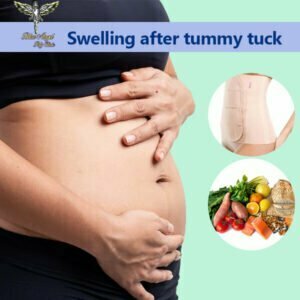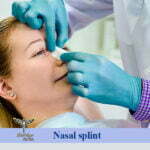Side effects after surgery are normal and can even be said to be a sign of your body’s recovery, and this applies to tummy tuck surgery as well. Since each patient has their unique healing process, depending on the body type, it is possible that the swelling after tummy tuck in the surgical area will be with the patient from 2 weeks to 6 months; Therefore, we found it necessary to examine all aspects of this type of swelling and how to treat inflammation in this article of Blue Angel Poly Clinic.

Tummy Tuck surgery and swelling after that
Tummy tuck, also called abdominoplasty, is one of the best and most effective solutions for removing excess fat and changing the shape of the abdominal area. We all know that a healthy diet and regular exercise can help us lose weight and look good and bring us to an ideal weight; But sometimes exercise and diet are not enough.
For example, in the case of damage caused by pregnancy or severe weight fluctuations, such as stretch marks and loss of skin elasticity, exercise and diet are not enough at all, and a more effective procedure is needed. Therefore, the best tummy tuck surgeon in Dubai suggests abdominal surgery to help solve the aforementioned problems.
Through this surgery, they tighten the stomach muscles and then remove loose skin and fat from the abdominal area. We have talked about the advantages and benefits of abdominoplasty, but note that this operation, like any other operation, has some complications that you should be aware of before doing this surgery. An important complication that we are going to examine today is swelling after tummy tuck. So, in the following, we will talk about the cause of swelling and how to reduce the severity.
The cause of swelling after tummy tuck
The main cause of swelling after abdominoplasty is related to the lymphatic vessels and blood vessels in this area of the body. If we want to explain more simply, we must say that when you undergo this cosmetic procedure, both the blood supply of the surgical area and the lymphatic system are affected, and since this procedure requires incisions along the pubic area, the skin above it and also the blood vessels are manipulated; Therefore, blood may not reach this area easily and thus the skin gradually reacts and swells.
In addition, by interrupting and changing the lymphatic system that is responsible for draining body fluids, the possibility of fluid accumulation increases, and in this way, fluid may accumulate in the abdomen or somewhere near your legs and thighs. This is why some patients who have undergone body contouring report leg swelling. To prevent swelling after tummy tuck operation, patients should have a drain for a few days after the surgery.
Swelling varies from person to person but is usually at its worst in the first two months after surgery. After the operation and during the patient’s recovery, at the same time as the lymphatic and blood vessels are restored, the swelling will gradually disappear. This healing process can take up to 6 months or more, so there is nothing to worry about if you have abdominoplasty and notice some swelling months later.
The amount of swelling after surgery also depends on the procedure you perform. For example, mini abdominoplasty usually has less recovery time and swelling compared to full or traditional abdominoplasty, or on the other hand, the combination of liposuction and tunnu tuck causes swelling in other areas of the body. But what is the solution? How can this swelling be reduced and gotten rid of it faster?!
How to help reduce the swelling after tummy tuck operation?
There are several measures that you can take to reduce swelling after tummy tuck and thus reduce your recovery time and achieve the flat stomach and body you want sooner:
An experienced surgeon is all you need
Note that postoperative complications largely depend on the surgery itself, so choosing an experienced surgeon is more important than the surgery itself. To have an easier and shorter recovery, you need to find a knowledgeable and experienced surgeon who can manage your treatment course well and guide you with proper instructions.
To reduce swelling after tummy tuck, the less tissue the doctor tears or manipulates, the better. The post-operative stage is more important than the surgery, and it is at this stage that you should take special drugs to reduce inflammation and swelling as prescribed by the doctor. Therefore, it is necessary to listen to the doctor and follow his recommendations.
On the other hand, the communication of patients with the best plastic surgeon for tummy tuck in Dubai during recovery and after the surgery is very important, and this means more than attending subsequent visits. Any questions or concerns of the patient should be raised with the surgeon immediately so that various issues can be addressed promptly. This issue is necessary not only to ensure health but also to calm the patient’s mind.
Wearing a compression garment for about two weeks
Compression garments should be among the clothes you wear during the day. A compression garment that is neither too loose nor too tight will help you control swelling after tummy tuck by applying pressure and limiting the amount of fluid in the surgical area. These clothes have other advantages, which include:
- Reduce bruising and bleeding
- Accelerate the healing process
- Skin folds
- Shaping and shaping the abdomen and waist area
- Reduce the risk of infection
- Reducing pain and discomfort after surgery
Appropriate diet
Healthy food can certainly speed up your recovery. By adding high-fiber foods, fresh fruits, and grains to your daily diet, you can control swelling after tummy tuck. Also, drink as much water as possible to prevent fluid retention. Some golden tips for diet after abdominoplasty:
Drink water: Drinking a lot of water after abdominal surgery works like a miracle to help the body heal faster. Dehydration, as well as pain medications and a low-fiber diet, can cause constipation and ultimately lead to abdominal pain. Drinking water, fruit juice, light, and diluted tea, or watery foods such as soup are very useful for the diet after abdominoplasty.
Carbohydrates: Carbohydrates generally help to restore the body’s strength and speed up the recovery process. They prevent muscle loss and speed up the rejuvenation process. Whole grains, oatmeal, brown rice, etc. are good sources of healthy carbohydrates that can do wonders for your recovery.
Vitamins: Taking vitamins A and C after the operation ensures the healing of scars and stitches, helps skin regeneration, and reduces bruising and the risk of infection. You can find vitamin A in eggs, cod liver oil, and dairy products, and vitamin C in citrus fruits, vegetables, strawberries, and tomatoes.
Proteins: Protein is a key parameter in building new cells and structures and generally in the healing process. Daily consumption of eggs, lean fish, lean meat, beans, nuts, dairy products such as yogurt, etc. will make you largely unneeded for proteins.
Placing a drain in the surgical incision site
Sometimes, the abdominoplasty surgeon uses drains during or after surgery to help remove fluids that collect at the surgical site and result in swelling after tummy tuck. It may seem strange to you that your body needs to be drained after abdominal surgery, but you should note that draining excess fluids is necessary to help your body recover from surgery and prevent infection.
Usually, as a defensive reaction, the body sends fluids to the injured area, and these fluids lead to pain and swelling.
Drains speed up the process of draining excess fluid, thereby preventing swelling and infection, and in turn, helping the patient recover faster. They are thin, clear silicone tubes that are inserted through very small incisions behind the main incision and end up in the area between the chest and pubic area or a smaller slit at the bottom of the incision made in the abdomen.
Simple and regular activity
One of the most important recommendations that the best tummy tuck surgeon in Dubai will give you after the operation is to have complete rest and avoid heavy activities, especially in the first weeks. With all this, light activity is not only not dangerous, but also very important to reduce the risk of blood clots, thus helping to reduce swelling after tummy tuck.
Don’t forget that you won’t be able to do any strenuous exercise for several weeks, but you can do simple thigh and calf exercises while you rest in bed to keep your circulation going. Bending the leg and thigh muscles and doing heel exercises can be good exercises, provided that these movements do not put any pressure on your abdominal muscles.



